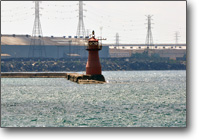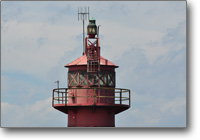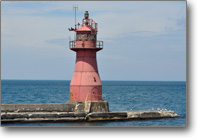| Historical Information
Formed in 1901 as an
amalgamation of Carnegie Steel, Federal Steel and a number of other
small companies, the alumni of the Pittsburgh based US Steel
Corporation were a veritable “Who’s Who” of American
Industry. Created by J. P. Morgan, Elbert H and Andrew
Carnegie, with Charles M. Schwab serving as its first President, within
four years of its founding, the company was experiencing meteoric
growth, with its eye on dramatically expanding its operations.
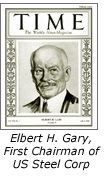 With a need to locate close to
a harbor to receive ore, coal and limestone, to rail lines to ship
finished product, and to a population center which could fill the
numerous jobs the new mills would create, it quickly became evident
that the area around Chicago provided the key to the company’s growth
potential. However, water front property in the Chicago area was
virtually nonexistent and prohibitively expensive in those rare cases
in which it became available. Taking a cue from competitor Inland
Steel, which had previously purchased unimproved lakeshore to build its
base of operations at Indiana Harbor, US Steel Chairman Elbert H. Gary
set his sights on the sprawling Indiana dunes two miles to the east of
Indiana Harbor as a potential site at which to base its expansion. With a need to locate close to
a harbor to receive ore, coal and limestone, to rail lines to ship
finished product, and to a population center which could fill the
numerous jobs the new mills would create, it quickly became evident
that the area around Chicago provided the key to the company’s growth
potential. However, water front property in the Chicago area was
virtually nonexistent and prohibitively expensive in those rare cases
in which it became available. Taking a cue from competitor Inland
Steel, which had previously purchased unimproved lakeshore to build its
base of operations at Indiana Harbor, US Steel Chairman Elbert H. Gary
set his sights on the sprawling Indiana dunes two miles to the east of
Indiana Harbor as a potential site at which to base its expansion.
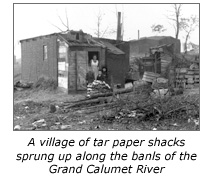 After consummating the
necessary land purchases in 1905, U. S. Steel formed a subsidiary by
the name of Indiana Steel which would be charged with building and
operating the new plant. As a result of the completely unimproved
nature of the dunes, the formidable task of leveling and preparing the
land was already underway in the spring of 1906. With no local
accommodations in this virtual wilderness, a village of tar paper
shacks quickly sprang up along the shore of the Grand Calumet River to
serve as temporary housing for the thousands of workers and their
families who swept into the area to help clear the land and build the
mills and harbor. Working teams of horses and mules pulling grader
blades and wagons, the army of workers made innumerable passes along
the dunes to level the hills and valleys, removing many thousands of
tons of sand, marshland and vegetation in the process. After consummating the
necessary land purchases in 1905, U. S. Steel formed a subsidiary by
the name of Indiana Steel which would be charged with building and
operating the new plant. As a result of the completely unimproved
nature of the dunes, the formidable task of leveling and preparing the
land was already underway in the spring of 1906. With no local
accommodations in this virtual wilderness, a village of tar paper
shacks quickly sprang up along the shore of the Grand Calumet River to
serve as temporary housing for the thousands of workers and their
families who swept into the area to help clear the land and build the
mills and harbor. Working teams of horses and mules pulling grader
blades and wagons, the army of workers made innumerable passes along
the dunes to level the hills and valleys, removing many thousands of
tons of sand, marshland and vegetation in the process.
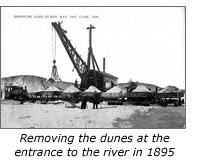 Chicago’s Great Lakes Dock and
Dredge Company was awarded the contract to build what would become
known as Gary Harbor, and while work was underway on shore, a fleet of
dredges, barges, tugs and workers, were busy excavating a huge 25-foot
deep channel some 5,000 feet long and 250 feet wide into the shoreline
to supply the planned compliment of twelve blast furnaces and
forty-seven steel furnaces. At the inner end of this huge slip, a
750-foot turning basin, large enough to allow the largest steamers of
the day to make a turn, was established. Chicago’s Great Lakes Dock and
Dredge Company was awarded the contract to build what would become
known as Gary Harbor, and while work was underway on shore, a fleet of
dredges, barges, tugs and workers, were busy excavating a huge 25-foot
deep channel some 5,000 feet long and 250 feet wide into the shoreline
to supply the planned compliment of twelve blast furnaces and
forty-seven steel furnaces. At the inner end of this huge slip, a
750-foot turning basin, large enough to allow the largest steamers of
the day to make a turn, was established.
To serve as a protection to
the channel entrance, two 2,000 foot long parallel piers were erected
at its mouth, also with a width of 250 feet between them as an
extension to the dredged channel. To serve as a range for vessels
approaching the harbor, the outer end of the west pier was lighted with
a skeletal iron tower equipped with an acetylene illuminating apparatus
at a height of 30 feet above the water, with a second similar structure
with its light located at 45 feet above the water some 200 feet to the
rear of the pierhead light to serve as the rear range.
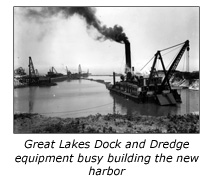 With construction of the
harbor underway, a subsidiary of Indiana Steel known as the Gary Land
Company was formed to plan, lay out, and build both the mills and the
town of Gary. The mills and the town were built simultaneously.
Broadway Street and Fifth Avenue were designated as the two main
thoroughfares, with Broadway running from the south end of town
northward toward the main gate of the steel mill. When building the
town, workers initially laid out streets and sidewalks, and then began
construction of public and commercial structures. In a clear indication
of Gary's identity as a “company town,” the city hall and public
library were built on Broadway to the north of Fifth Avenue, and
immediately facing the main mill entrance. With construction of the
harbor underway, a subsidiary of Indiana Steel known as the Gary Land
Company was formed to plan, lay out, and build both the mills and the
town of Gary. The mills and the town were built simultaneously.
Broadway Street and Fifth Avenue were designated as the two main
thoroughfares, with Broadway running from the south end of town
northward toward the main gate of the steel mill. When building the
town, workers initially laid out streets and sidewalks, and then began
construction of public and commercial structures. In a clear indication
of Gary's identity as a “company town,” the city hall and public
library were built on Broadway to the north of Fifth Avenue, and
immediately facing the main mill entrance.
Down in the harbor, it was
soon found that vessels docked within the channel were buffeted by
northerly winds, and to further protect in such conditions, two
cross-channel piers were erected in order to create a rudimentary
stilling basin. The outer cross-channel pier extended 133 feet at a
right angle from the east pier, and the inner cross-channel pier
extended 160 feet at a right angle from the west pier approximately 790
feet inside the outer cross-channel pier. These cross channel piers
left a clear space of 90 feet between the piers for vessels to enter
and exit the channel. Minor post lights also graced the end of the west
pier and the inner ends of both cross-piers.
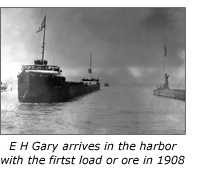 In a grand celebration
attended by company dignitaries and newspaper men from far and wide,
the US Steel owned ore boat E. H. GARY arrived with the first load of
ore from the Mesabi mines on July 23, 1908. On December 21st
of that same year, the first blast furnace was fired, and the mill was
in operation a little over two years after the first load of sand was
cleared from the dunes to make way for the complex. In a grand celebration
attended by company dignitaries and newspaper men from far and wide,
the US Steel owned ore boat E. H. GARY arrived with the first load of
ore from the Mesabi mines on July 23, 1908. On December 21st
of that same year, the first blast furnace was fired, and the mill was
in operation a little over two years after the first load of sand was
cleared from the dunes to make way for the complex.
With U.S. Steel now serving as
one of the largest companies in his district, Indiana Congressmen
Crumpacker introduced wording into the 1910 River and Harbor Bill
through which the federal government was requested to evaluate the
harbor at Gary with an eye on taking on responsibility for its future
maintenance and lighting. However, in hearings on the bill in Congress
that year, it was determined that since the harbor solely served the
interests of US Steel and its subsidiaries, it was not in the general
interest of area commerce to absorb the harbor, and unless the scheme
of development of the harbor were modified so as to permit a more
general use, the federal government was not bound to accept any
responsibility for its ongoing maintenance.
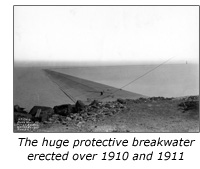 The cross piers proved to be a
less than successful solution, and without the prospect of receiving
any federal assistance in improving the harbor, over 1910 and 1911 the
company had no alternative but to build a substantial breakwater
emanating from the western side of the harbor to fully protect the
channel from northern seas. Constructed of stone-filled timber cribs,
the upper surface of the breakwater was covered in pine boards in order
to create a substantial deterrent to waves. The cross piers proved to be a
less than successful solution, and without the prospect of receiving
any federal assistance in improving the harbor, over 1910 and 1911 the
company had no alternative but to build a substantial breakwater
emanating from the western side of the harbor to fully protect the
channel from northern seas. Constructed of stone-filled timber cribs,
the upper surface of the breakwater was covered in pine boards in order
to create a substantial deterrent to waves.
Since vessels would now need
to make a sharp turn around the end of the breakwater in order to align
themselves for entry into the channel, a new and more substantial light
was erected on a concrete base at the breakwater’s outer end. The
structure consisted of a maroon-painted, stepped cylindrical tower
capped by a 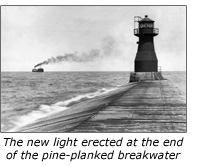 lantern with helical astragals housing a lens lantern at a
focal plane of 40 feet above the lake level. Powered by acetylene gas
from tanks stored in the base of the tower, the light output 900
candlepower and was automatically lighted at dusk and extinguished at
dawn through the use of a sun valve. As was the case with virtually all
acetylene lighting systems, the light exhibited a fast flash in order
to conserve the expensive gas. Exhibiting a repeated 15.7 second
characteristic consisting of a 2 second flash lantern with helical astragals housing a lens lantern at a
focal plane of 40 feet above the lake level. Powered by acetylene gas
from tanks stored in the base of the tower, the light output 900
candlepower and was automatically lighted at dusk and extinguished at
dawn through the use of a sun valve. As was the case with virtually all
acetylene lighting systems, the light exhibited a fast flash in order
to conserve the expensive gas. Exhibiting a repeated 15.7 second
characteristic consisting of a 2 second flash  followed by a 2.7 second
eclipse, a second 2 second flash and an eclipse of 9 seconds, the new
Gary Breakwater light was exhibited for the first time on the night of
July 5th, 1911. To help provide guidance during thick weather, the
structure was also equipped with a six-inch air operated siren which
emitted a repeated characteristic of a 2 second blast followed by 28
seconds of silence. followed by a 2.7 second
eclipse, a second 2 second flash and an eclipse of 9 seconds, the new
Gary Breakwater light was exhibited for the first time on the night of
July 5th, 1911. To help provide guidance during thick weather, the
structure was also equipped with a six-inch air operated siren which
emitted a repeated characteristic of a 2 second blast followed by 28
seconds of silence.
Under Chairman Elbert H.
Gary’s stewardship, U.S Steel continued to grow to incredible
proportions. By 1916 he was leading a corporate empire with income and
resources greater than most countries. For that year alone, the
company’s gross receipts topped $1,230,000,000, and employed over
275,000, more than the US army and navy combined. If laid
end-to-end, the company’s fleet of over 100 steamers would stretch over
ten miles, and its own railroad lines would have stretched from San
Francisco to New York and a couple hundred miles beyond.
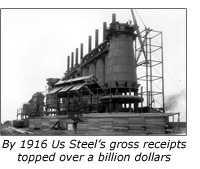 As the years passed, U.S.
Steel's corporate mission and structure passed through a number of
changes. As demand for domestic steel dropped in the 1980s, U.S. Steel
went through a major restructuring, diversifying its holdings into the
energy and transportation sectors and ultimately adopted the name USX
Corporation. In 2001, shareholders voted to separate the steel
component of its business from USX and reestablished a new publicly
traded company under the original name, U.S. Steel Corporation. After
this reorganization, the Marathon Oil Company emerged from former USX
energy sector businesses. As the years passed, U.S.
Steel's corporate mission and structure passed through a number of
changes. As demand for domestic steel dropped in the 1980s, U.S. Steel
went through a major restructuring, diversifying its holdings into the
energy and transportation sectors and ultimately adopted the name USX
Corporation. In 2001, shareholders voted to separate the steel
component of its business from USX and reestablished a new publicly
traded company under the original name, U.S. Steel Corporation. After
this reorganization, the Marathon Oil Company emerged from former USX
energy sector businesses.
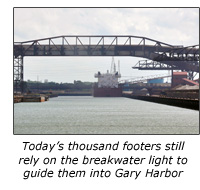 U.S. Steel continues to
maintain its headquarters in Pittsburgh, and maintains a significant
presence among worldwide steel companies. It maintains large-scale production operations in the U.S., Canada and Central Europe, as well
as joint ventures in Mexico and South America. In 2007, it was ranked
by the World Steel Association as the world’s tenth largest steel
producer. U.S. Steel continues to
maintain its headquarters in Pittsburgh, and maintains a significant
presence among worldwide steel companies. It maintains large-scale production operations in the U.S., Canada and Central Europe, as well
as joint ventures in Mexico and South America. In 2007, it was ranked
by the World Steel Association as the world’s tenth largest steel
producer.
Today,
the old 1911 Gary
Breakwater light and diaphragm horn receive their power from an
electrical conduit which runs out along the concrete breakwater from
shore. While certainly not as busy as they were when US Steel reigned
as the single largest steel producer in the world, today’s
thousand-footers still look for the Gary Harbor light as they seek to
make their turn around the breakwater and into the docks in the channel
to unload Lake Superior ore for the hungry steel mills.

Seeing this Light

Because the breakwater and
lighthouse are both on private property, and there are numerous large
buildings between any public access areas and the lighthouse, the light is virtually impossible to see from the
land. Either a private boat or a vessel chartered from a local fisherman
represent the only opportunitis to obtain a good view of this light.
Both the Great Lakes Lighthouse Keepers Association and the United
States Lighthouse Society offer infrequent tours of the suth end of
Lake Michigan, both of which have always provided great close-up views
of this and the other lighthouses of the area. GPS Coordinates: 41°37'49.17"N x 87°19'13.03"W
Reference sources
Hammond Times newspaper, February 12, 1909
Report on the River & Harbor Bill, 1910
Cleveland Plain Dealer newspaper, various
Report of Hydrographic information for Lake Michigan, 1911
Annual reports of the Lake Carriers Asssociation, various
Chicago, Its History & Builders, J Seymour Currey, 1912
Great Lakes Light Lists, various |
